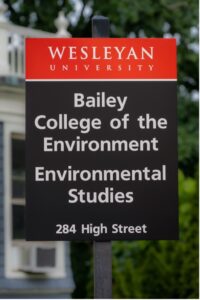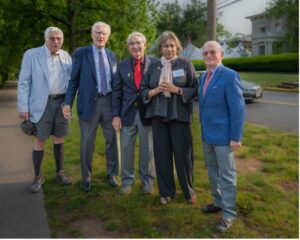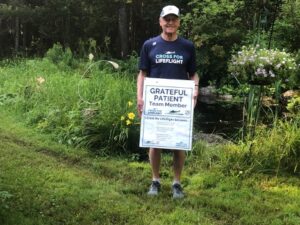CLASS OF 1966 | 2023 | FALL ISSUE
We begin with a telling photograph.
On the evening of May 24, 2023, President Roth gathered together members of the Wesleyan University community for a ceremony at the College of the Environment to honor, celebrate, and thank Essel Bailey and his wife, Menakka Bailey, for helping to found and support what will now be known as the Bailey College of the Environment. A dinner at the president’s home followed. As Essel has often and rightly noted: “The most significant challenges we face today are environmental.” Thanks to Essel and Menakka’s vision and generosity, the Bailey College of the Environment will soon have new, updated quarters in a renovated Shanklin Hall, funding for student research projects, and an endowment to support interdisciplinary faculty work on environmental issues. Essel (my one claim to fame moving forward will to have been Essel’s roommate sophomore year in North College) wrote to me, with an exclamation mark, “Our whole family, kids, grandkids, and siblings” attended the dinner as did one of Essel’s faculty mentors, Professor Nat Greene. Rick Crootof, Sandy Van Kennen, and Will Rhys represented the Class of 1966.
Wesleyan students and faculty today and for years to come will be inspired by, and benefit from, Essel and Menakka’s vision and support. On behalf of your fellow classmates, thank you Essel and Menakka.
Although he retired as distinguished professor of psychology from the University of California, Davis, eight years ago, Phil Shaver has not let grass grow under his feet, writing: “I have continued working on research and writing projects with other (younger) people. One of them, a very creative Israeli professor, Mario Mikulincer, and I have two new books out, both with long academic titles, I’m afraid: (1) Attachment Theory Expanded: Security Dynamics in Individuals, Dyads, Groups, and Societies; (2) Attachment Theory Applied: Fostering Personal Growth through Healthy Relationships.” For his many scholarly contributions to the field of psychology over many years, Phil will be honored—and what an honor it is—in September with induction into the American Academy of Arts and Sciences. Not sure where he finds the time, but Phil has also “been taking watercolor painting classes and playing golf a couple of times a week, until three weeks ago, when I had to have knee replacement surgery. Throwing your weight leftward while pivoting on the left knee gradually wears the knee out. My workaholic professor wife, Gail Goodman (who has not retired yet), and our 27-year-old twin daughters, both of whom live nearby, are a lot of fun and treat me very well.”
Clark Byam, who lives in Pasadena, California, continues “to hike and play some golf. Also have a lot of Goggle stock, so good retirement accounts. Wasn’t recommended by a broker but years ago Wall Street Journal article I read said if you don’t know what to invest in . . . invest in Google. Best advice I ever got.”
On May 25, Barry Thomas sent this wonderfully informative update: “A couple months has passed since Connie and I returned from Burundi. Other than just being a bit lazy, the only excuse is that I have been a bit under the weather for a couple weeks. Nothing serious or chronic, and I am getting better. Just getting old which, I am coming to understand, is serious enough.
“The time in Burundi during February was very good. We were joined by another couple . . . Ana is an early childhood education person who had helped Connie with the online training programs during the pandemic years. Her husband is a now retired professor of religion at Appalachian State. They found the experience to be . . . extraordinary—of course, seeing all the negatives involved with the extreme poverty but, on the other hand, all the good work being done by the Dreaming for Change staff. Connie and Ana had a rewarding three weeks working with the teachers and the children. There are now 130 children in the school that includes a first primary grade. D4C has experienced an influx of children and mothers in recent weeks as they seem to be coming from greater distances for food and other help. Part of the issue is that D4C is becoming known in the province as a good place where food and a nurse’s care are being provided.
“During our visit, D4C celebrated a fifth anniversary. The place of trust that has been built with the community is noteworthy. Connie and I were also impressed with the staff Janvier has attracted and the organization he is putting together. In my time working in poor places, I have learned that, aside from the bad political leadership and governance, the main factor holding people in their subsistence life is the absence of organization management and just plain organizational work experience.”
David Luft plays in a different league. He is now “learning Czech and working on a book about Czech intellectual history since the 15th century.” He “started earlier with Spanish and Latin, and my real love, of course, was English. Thanks to Beckham and COL, I did get pretty good at German, and I kept at it. But I got interested in Austria, which was where Musil was from. So, there was a lot for me to unpuzzle about languages. And then in 1980, Solidarity made me want to learn Polish.” Of course! “For the past 20 or 25 years, I have been learning Czech and Polish in a chaotic way. It’s demanding . . . but pretty interesting. I can see Russia more clearly from there and understand Austria and Germany much better. I did learn some Russian in the 1980s, and Czech and Polish are closer to Russian than to German.”
Tom Pulliam worries that “my story is a little monotonous.” Hardly, Tom. What a life you are living! Tom is “coaching rugby at Stanford (mostly with women’s team who finished third in country last season) and with kids ages 10–14 at San Francisco Golden Gate Rugby Club—absolutely loving it—and still watching three grandsons (10, 13, and 16), who live seven minutes away, play baseball, flag football, and soccer. The 13- and 16-year-old [are] now playing MLSNext soccer, which is highest youth level in the U.S., but prevents them from playing anything else because it is so intense.” Tom’s “granddaughter is headed to sophomore year at University of Hawaii and is extremely happy there, studying marine biology. I am determined to get over there for visit and to see Hardy Spoehr.”
Shortly after hearing from Tom, I got this note from Hardy Spoehr: “Aloha, Larry. . . . Nothing much to report here except our second hurricane of the season is moving slowly toward us. Also, just want to put a plug in [for] Wesleyan’s ongoing webcasts of its athletic events . . . looking forward to viewing this year’s teams with my morning cup of coffee. . . . He Ola Kakou—be well.” Both Tom and Hardy wrote before the devastating wildfires in Maui.
Al Burman writes that he and his wife, MJ, are “still enjoying work and spending most of our time in Arlington, Virginia, and Sausalito, California, where quite some time back we had a chance for a nice catch-up with Barry Reder and Phil Shaver and their spouses. I was very sorry to hear about Frank Burrows.” Al attaches this photograph “of my wife MJ and me from our Amsterdam-to-Bruges bicycle-barge tour in June 2022. It was great fun and we are off to Mallorca for a similar ride in November.”
Great missive from Joel Russ who writes: “Carolyn and I celebrated our 55th wedding anniversary this year. We are now living in South Bristol, Maine, to be near three grandchildren (two of whom are off to college at Oberlin College and Conservatory and Williams) and are enjoying semiretirement. Carolyn retired after 33 years of public school teaching, and I in a variety of community-based nonprofits in Maine. I still do a little strategic planning and facilitation consulting for Maine-based nonprofit organizations, serve on three local nonprofit boards (land conservation, early childhood education, and chamber music), and one statewide nonprofit board, the Maine Gun Safety Coalition. I also coach the local elementary school cross-country and track and field teams. Trying hard to stay fit and busy.
“My most important activity at the present time, however, is to help raise funds for a critically important Maine resource, LifeFlight Maine, Maine’s only emergency helicopter and air rescue service. This service is particularly important to Maine’s rural and coastal island communities. In the past 25 years, LifeFlight Maine has transported over 36,000 Maine residents of all ages, most of whom were experiencing life-threatening conditions.
“This is my personal story and why I am so committed. Twelve years ago our daughter-in-law, KC Ford (our son Matt’s wife), was a passenger in a small plane that sank soon after leaving Matinicus Island, located 21 miles off the Maine coast. KC sustained serious, life-threatening injuries. Had it not been for a LifeFlight Maine emergency helicopter, KC would most likely not have survived. As you can imagine, our gratitude toward LifeFlight Maine is immense. I have committed to express that gratitude by participating in a major fundraiser, Cross for LifeFlight, a self-directed athletic activity. My goal is to run 100-plus miles in the month of August and to raise $6,000.” Here’s a photograph of Joel the runner and one capturing the cause.
Ever so good to hear from John Stremlau, Hon Professor of International Relations at the University of the Witwatersrand. John writes: “My wife and I returned to Johannesburg in 2015, where I am working on a comparative study of the politics and international relations of South Africa and the U.S. Reckoning with race in these two different and distant democracies is a major thread. Although it primarily deals with recent and contemporary events, on a more personal level, I recall my formative experiences on issues of nonracialism and political equality, that really began during the 1960s at Wesleyan.
“I believe I owe a special debt to the late John D. Maguire, who was just out of grad school and a member of the faculty. He had developed a friendship with Dr. Martin Luther King, who he [brought to campus] several times during the 1960s. Meeting Rev. King, listening to his address in Foss Hill Hall and in smaller discussion groups, had an enduring impact on my life and still does. Indeed, I probably would not be here in South Africa, which I first visited in 1977 and became a permanent resident in 1999, or served in Atlanta as vice president for peace at the Carter Center (2006–15), had it not been for John Maguire. John, I think was born in Montgomery and in 1961, the year before our first year, was arrested along with MLK and another Wes colleague, David Swift, for joining one of the early freedom rides.”
John would very much like to hear “from any classmates who might have had a similar formative experience with Maguire and King during their four years at Wesleyan. It would be helpful to hear from them as a kind of reality check.” John can be reached at: jjstremlau@gmail.com or john.stremlau@wits.ac.za.
Those of us fortunate enough to live with him on the first floor of a Foss Hill dormitory freshman year referred to him as “the Great One.” That him is, of course, Alberto Ibargüen, who from being editor of The Wesleyan Argus went on to a distinguished career in journalism, among many accomplishments, becoming publisher of the Miami Herald. In 2005 Alberto became president and CEO of the John S. and James L. Knight Foundation, a philanthropic organization that invests in and supports media, arts, and culture. A New York Times article of March 24, 2023, let us know that Alberto is stepping down from that position. In its lead it says “He Brought an Artistic Flair to the Knight Foundation’s Philanthropy.” The article notes, “In its 18 years under Alberto Ibargüen, the organization funded punk shows in Detroit and poetry dropped from helicopters in Miami. As he prepares to retire, he talks about what might be next.” Congratulations to Alberto on a distinguished career. We wait to hear what is next for “the Great One.” (See: https://www.nytimes.com/2023/03/24/arts/design/alberto-ibarguen-retiring-knight-foundation.html).
From celebratory to sad news. Bob Dearth writes: “So sorry to learn of the passing of F. Sugden Murphy, one of my favorite fraternity brothers. We kept in touch often during the first five or 10 years out of Wesleyan and then drifted in different directions as we aged and our families grew. Then later, after he has moved to New Hampshire, I learn he has become good acquaintances with a friend from New Canaan whose wife was a classmate of my wife at Skidmore and who then moved his family to New Hampshire too. Many fond memories of our time together at Wesleyan and after. RIP.” Frederick Sugden Murphy Jr., known as “Skipper,” died on December 10, 2022. An obituary can be read here: https://www.seacoastonline.com/obituaries/pprt0381553.
And our classmate, Grant Holly, died on November 8, 2022. In 1970 Grant accepted a position as assistant professor of English at Hobart and William Smith Colleges, where he would serve for the next 52 years, a greatly admired and cherished teacher and colleague. Many of you may not have known him at Wesleyan, as he and his wife, Michael Ann, and their daughter, Lauren, lived off campus. He and I, however, became close friends, both majoring in English, both writing our senior theses in the basement cubicles of Olin Library. That friendship deepened as we went on to complete our graduate degrees at the University of Rochester, writing our PhD theses under the same mentor, Professor James William Johnson. The friendship and good times I shared with Grant and Michael Ann beginning from our days at Wesleyan will always be cherished, his death shaking me. Grant, being the life force that he was, I thought would live forever. Here, if you have not seen them, are some links:
https://www.legacy.com/us/obituaries/latimes/name/grant-holly-obituary?id=37402268
https://www.hws.edu/news/2022/remembering-professor-grant-holly.aspx
https://www.hws.edu/offices/president/statements/statement-on-grant-holly.aspx
Let’s end on a happy note, this from the peerless Jeff Nilson, who begins with a photograph of his two grandsons, Isaac ’26, and William, “The tallest family member . . . age 17 . . . who plays the piano, the bass guitar, and the standup bass . . . wants to study music in Europe,” and Jeff’s daughter, Li ’88, mother of Isaac and William.
Jeff goes on to write: “I am still taking nourishment. I try to be grateful every day. I say to myself, ‘This is the day you are given. Rejoice in it.’ Jeff has “started my third children’s book. It is an easy-to-read mystery narrated by a bulldog named Daisy.” Here, the opening lines of Sally, Daisy, and the Mystery of the Kidnapped Dogs:
“Someone was stealing dog toys from the dog park. But my sister Sally and I didn’t care. We are not fetchers. We aren’t jumpers either. We are sniffers and watchers. We are bulldogs with short legs and heavy bodies. We don’t jump. We don’t run. We waddle. We like a good snuggle and a good scratch behind the ears.
“Our favorite thing is sniffing. Every morning there are great smells on the sidewalk in front of the dog park: other dogs, a few cats, rats and mice, roaches, spiders, old hot dog juice, and drops of old ice cream.
“We hang out with our dog walker Keisha. Here’s a photo of Keisha, Sally, and me in front of the dog park in Fort Greene Park, Brooklyn: In that photo behind us, you can see a lot of jumping and fetching. But Sally and I are not one of those crazy fetchers.
“A couple of weeks after this photo was taken, some of my best friends disappeared. There was Alex the Greyhound and Felicia the mutt. She had one blue eye, one brown eye, and a lot of wisdom. I missed her. Who was taking our friends? No one knew how to stop the dognappers. And no one knew how to rescue our missing dog friends….”








